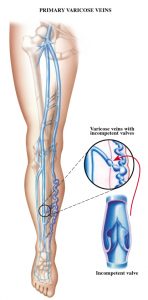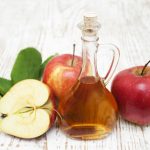Bothered by those swollen, twisted veins visible in your legs and feet? They don’t make you feel confident about putting on your bathing suit to go swimming or wearing shorts to make the most of the warm weather.
If this is you, though, you’re not alone.
Millions of Americans have varicose veins – estimates suggest up to 60 percent of men and women over age 60 have them and women are more prone – which is one reason varicose vein removal is a popular surgery. But there are more than cosmetic concerns.
What are varicose veins?
 As we’ve said, varicose veins aren’t pretty. Basically, they are gnarled, enlarged veins. Truly any vein can become varicose, but those most commonly affected are those in your legs and feet. Standing and walking increases the pressure in the veins of your lower body.
As we’ve said, varicose veins aren’t pretty. Basically, they are gnarled, enlarged veins. Truly any vein can become varicose, but those most commonly affected are those in your legs and feet. Standing and walking increases the pressure in the veins of your lower body.
Not all veins are swollen and unsightly, though. Some are small and commonly known as spider veins – a milder form of varicose veins – while others look like cords lying across the surface of the skin.
If you have them, you’d know that some of these veins hurt, but others are just unappealing to look at. Some varicose veins are harmless, while some may be signs of another medical condition entirely or lead to more serious problems like circulatory concerns. For some people, they can be painful, too.
Causes of varicose veins
 How do you get varicose veins in the first place? Arteries carry blood from your heart to the rest of your tissues, and then your veins return blood from the rest of your body through one-way valves to your heart, so the blood can’t flow backwards but is carried to your heart where it can be recirculated.
How do you get varicose veins in the first place? Arteries carry blood from your heart to the rest of your tissues, and then your veins return blood from the rest of your body through one-way valves to your heart, so the blood can’t flow backwards but is carried to your heart where it can be recirculated.
Diseases veins, however, have weakened valves, which allows blood to flow backward and pool inside the veins. This leads to a build-up of pressure inside the veins, resulting in venous disease.
The problem is, as you get older, your veins can lose elasticity causing them to stretch. That can make the valves in your veins weak. Blood pools in your veins, and your veins enlarge and become varicose.
They appear blue because they contain deoxygenated blood – it’s still in the process of being recirculated through the lungs. You’re also at higher risk for varicose veins if you have a family history of the problem.
Signs and symptoms of varicose veins
 Before we get to the nitty-gritty of preventing varicose veins, let’s examine the signs and symptoms. According to the Mayo Clinic, for the most part, varicose veins usually don’t cause any pain, so signs you may have varicose veins include:
Before we get to the nitty-gritty of preventing varicose veins, let’s examine the signs and symptoms. According to the Mayo Clinic, for the most part, varicose veins usually don’t cause any pain, so signs you may have varicose veins include:- Veins that are dark purple or blue in color
- Veins that appear twisted and bulging; often like cords on your legs.
If you do experience pain and discomfort, these symptoms may include:
- An achy or heavy feeling in your legs
- Burning, throbbing, muscle cramping and swelling in your lower legs
- Worsened pain after sitting or standing for a long time
- Itching around one or more of your veins
- Skin ulcers near your ankle, which can mean you have a serious form of vascular disease that requires medical attention.
As we’ve mentioned, spider veins are the most common form of varicose veins. They’re closer to the skin’s surface and are red or blue. They are found on the legs, but can also occur on the face. Why the name? Spider veins vary in size and often look like a spider’s web.
Preventive measures for varicose veins
While there’s no way to completely prevent varicose veins, improving circulation and muscle tone certainly can reduce your risk. Keep the following tips in mind:
- Exercising
- Watching your weight
- Eating a high-fiber, low-salt diet
- Avoiding high heels and tight hosiery
- Elevating your legs
- Changing your sitting or standing position regularly. Keep in mind that crossing your legs won’t cause varicose veins but can make them worse.
Home remedies for varicose veins
 As well as the preventative measures, there are excellent home remedies to put into practice. Consider the following:
As well as the preventative measures, there are excellent home remedies to put into practice. Consider the following:
Dietary changes. A practical place to begin is your diet. Start by consuming more vitamin C-rich foods. Also, eat a diet that is high in fiber, because fiber helps to prevent constipation and the straining that is associated with constipation can both cause and aggravate varicose veins. Finally, reduce your intake of salt, because salt can make varicose veins more visible by increasing swelling within the veins.
Horse chestnut seed extract. Horse chestnut is arguably one of the best herbal natural remedies for varicose veins. It contains a compound known as aescin that helps to thin the blood and promote circulation. It also helps to prevent fluid from leaking out of veins, and preliminary research suggests that it can reduce the swelling and discomfort associated with varicose veins.
For best results, choose a supplement that has the toxic compound esculin removed and that is standardized to contain at least 15 percent aescin.
Hot oil massages. Need another good reason for a massage? Regularly massaging your legs with essential oils will improve circulation, and may help to reduce the pain and swelling associated with varicose veins. Any essential oil will do, but Neroli oil is considered especially beneficial because it not only increases circulation, but also stimulates the growth of new cells.
The best way to perform the massage is to sit up with your legs raised slightly on a pillow, and to start from your ankles and work your way up to the top of your legs. Make gentle, upward strokes and spend about five minutes on each leg daily. Be sure to avoid directly massaging the varicose veins however, because this can aggravate them.
Apple cider vinegar. While there’s no hard science behind it, apple cider vinegar is one of the most highly touted natural remedies for varicose veins – and there is certainly no risk in trying it. Saturate a cloth in apple cider vinegar and apply it to your varicose veins for 30 minutes daily while elevating your legs in a comfortable position.
In addition to applying it externally, add one tablespoon of raw apple cider vinegar to a glass of water and drink one in the morning and then another glass at night. Consider rinsing your mouth after with water to avoid eroding tooth enamel because of the acidity.
With these natural remedies to prevent varicose veins, you can minimize your risk as you age and forget about costly removal surgery. Here’s to feeling great in your summer shorts!

No comments:
Post a Comment